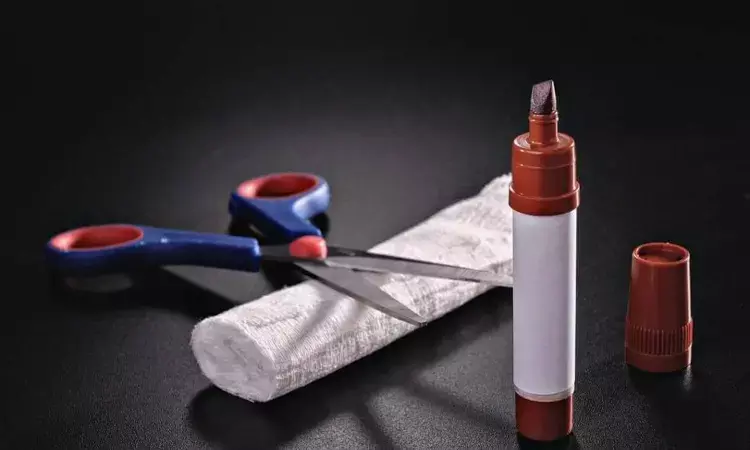- Home
- Medical news & Guidelines
- Anesthesiology
- Cardiology and CTVS
- Critical Care
- Dentistry
- Dermatology
- Diabetes and Endocrinology
- ENT
- Gastroenterology
- Medicine
- Nephrology
- Neurology
- Obstretics-Gynaecology
- Oncology
- Ophthalmology
- Orthopaedics
- Pediatrics-Neonatology
- Psychiatry
- Pulmonology
- Radiology
- Surgery
- Urology
- Laboratory Medicine
- Diet
- Nursing
- Paramedical
- Physiotherapy
- Health news
- Fact Check
- Bone Health Fact Check
- Brain Health Fact Check
- Cancer Related Fact Check
- Child Care Fact Check
- Dental and oral health fact check
- Diabetes and metabolic health fact check
- Diet and Nutrition Fact Check
- Eye and ENT Care Fact Check
- Fitness fact check
- Gut health fact check
- Heart health fact check
- Kidney health fact check
- Medical education fact check
- Men's health fact check
- Respiratory fact check
- Skin and hair care fact check
- Vaccine and Immunization fact check
- Women's health fact check
- AYUSH
- State News
- Andaman and Nicobar Islands
- Andhra Pradesh
- Arunachal Pradesh
- Assam
- Bihar
- Chandigarh
- Chattisgarh
- Dadra and Nagar Haveli
- Daman and Diu
- Delhi
- Goa
- Gujarat
- Haryana
- Himachal Pradesh
- Jammu & Kashmir
- Jharkhand
- Karnataka
- Kerala
- Ladakh
- Lakshadweep
- Madhya Pradesh
- Maharashtra
- Manipur
- Meghalaya
- Mizoram
- Nagaland
- Odisha
- Puducherry
- Punjab
- Rajasthan
- Sikkim
- Tamil Nadu
- Telangana
- Tripura
- Uttar Pradesh
- Uttrakhand
- West Bengal
- Medical Education
- Industry
Combination of betadine and silver colloidal gel may effectively treat large wounds and burns

Researchers have found in a new study that combination of betadine and silver colloidal gel can effectively eliminate infection-causing bacteria. Further this combination is more effective than either material alone for inhibiting the growth of common infection-causing bacteria. These research findings could help medical professionals better treat and prevent serious infections in large wounds, including burns.
The new study has been published in the American Journal of Infection Control (AJIC).
"Despite substantial advancements in wound treatment and supportive care, wound infections remain a serious problem, particularly in the case of large burns," said Jonathan Kopel, PhD, medical student, Texas Tech University Health Sciences Center, and a study author. "Our study is the first to systematically evaluate the use of betadine alone as compared to the combination of betadine and silver colloidal gel to eliminate bacteria and the growth of biofilms."
Large wounds such as serious burns are vulnerable to microbial invasion and the production of biofilms, microbial colonies that can become attached to a wound surface and delay or prevent healing. While the topical antiseptic betadine is widely used in the treatment and prevention of wound infections because it has a particularly broad spectrum of antimicrobial activity, many studies have suggested it is ineffective against some bacteria.
Topical antimicrobial dressings, including those containing silver, have long been used to support treatment and prevention of wound infections, and seem to provide a different microbial killing mechanism than betadine.
Dr. Kopel and colleagues measured the effectiveness of 5% betadine solution alone, silver colloidal gel (Ag-gel) alone, and the combination of 5% betadine and Ag-gel for inhibiting the growth of five laboratory strains of bacteria: Staphylococcus aureus (S. aureus) and Pseudomonas aeruginosa (P. aeruginosa), the predominant infective organisms in the clinically significant microbiome of large, acute burns, as well as clinical isolates of Klebsiella pneumoniae (K. pneumoniae), Staphylococcus epidermidis (S. epidermidis), and Methicillin-resistant S. aureus (MRSA).
After incubating each of the five bacterial strains for 24 hours to grow biofilms, the researchers prepared cellulose paper discs with each of the three test solutions and exposed the discs to the biofilms. The researchers then analyzed the concentrations of bacteria that remained in each case, using both a standard, reliable testing assay and advanced imaging. Results showed:
- The combination of 5% betadine and Ag-gel provided complete (100%) inhibition of all five bacterial strains tested.
- Five percent betadine alone showed little or no inhibition of P. aeruginosa, and at best approximately 90 percent (1 log) inhibition of the other four bacterial strains tested.
- Ag-gel alone inhibited 100% of bacterial growth (7 logs) among all bacterial strains except K. pneumoniae.
- Notably, while 5% betadine alone killed only about 90% of K. pneumoniae, betadine and Ag-gel combined killed 100%. This reinforces the researchers' assertion that betadine works by a different bacterial killing mechanism than Ag-gel.
"Wound infections continue to be a significant challenge for medical professionals and patients, leading to increased morbidity, mortality, and healthcare cost every year," said Linda Dickey, RN, MPH, CIC, FAPIC, 2022 APIC president. "This study provides important new findings that could help improve infection prevention and treatment to reduce this burden."
Reference:
Phat Tran, Jonathan Kopel, Keaton Luth, Huy Dong, Ameesh Dev, Dilip Mehta, Kelly Mitchell,Keith W. Moeller, Cameron D. Moeller, Ted Reid, Published: April 15, 2022 DOI: https://doi.org/10.1016/j.ajic.2022.04.002
Dr Kamal Kant Kohli-MBBS, DTCD- a chest specialist with more than 30 years of practice and a flair for writing clinical articles, Dr Kamal Kant Kohli joined Medical Dialogues as a Chief Editor of Medical News. Besides writing articles, as an editor, he proofreads and verifies all the medical content published on Medical Dialogues including those coming from journals, studies,medical conferences,guidelines etc. Email: drkohli@medicaldialogues.in. Contact no. 011-43720751


